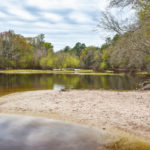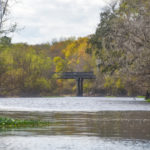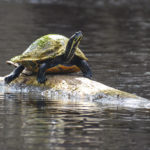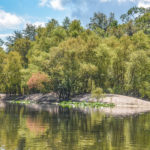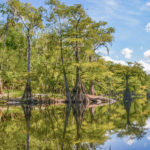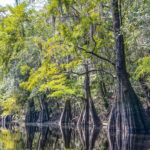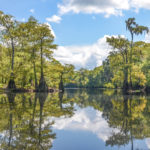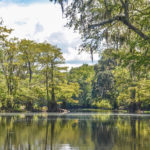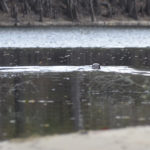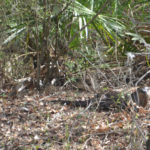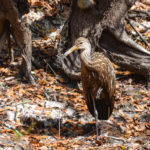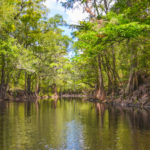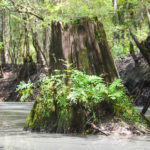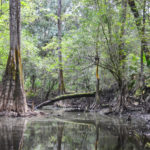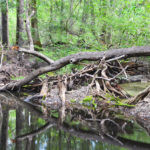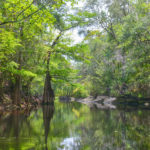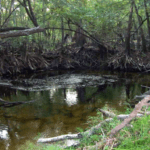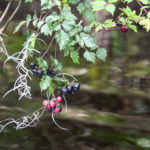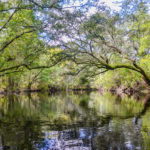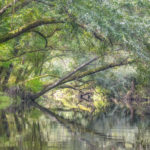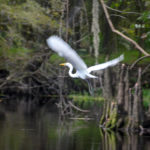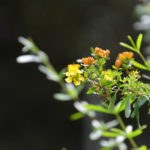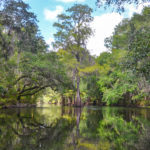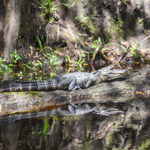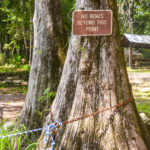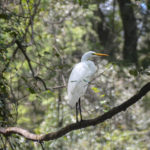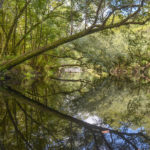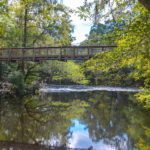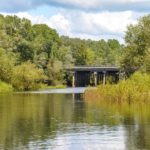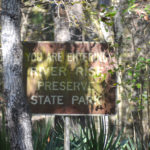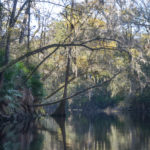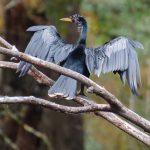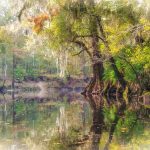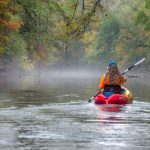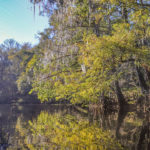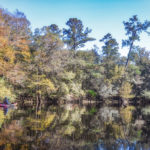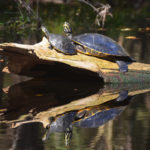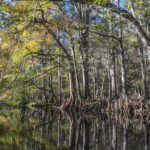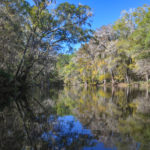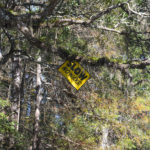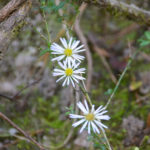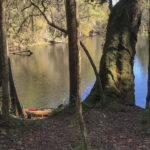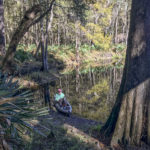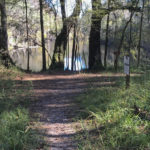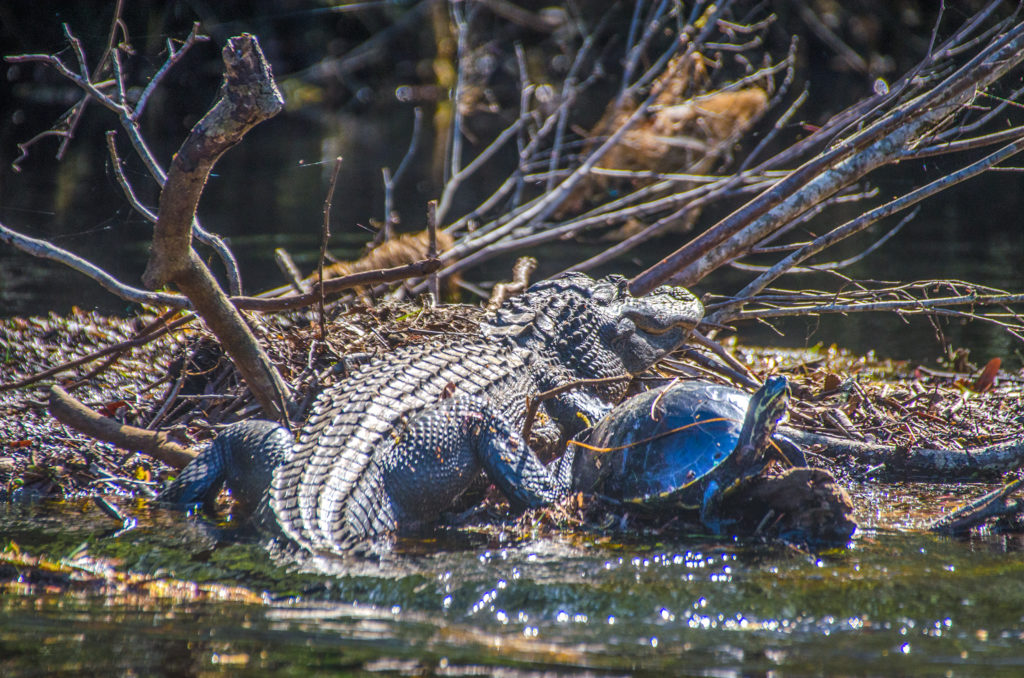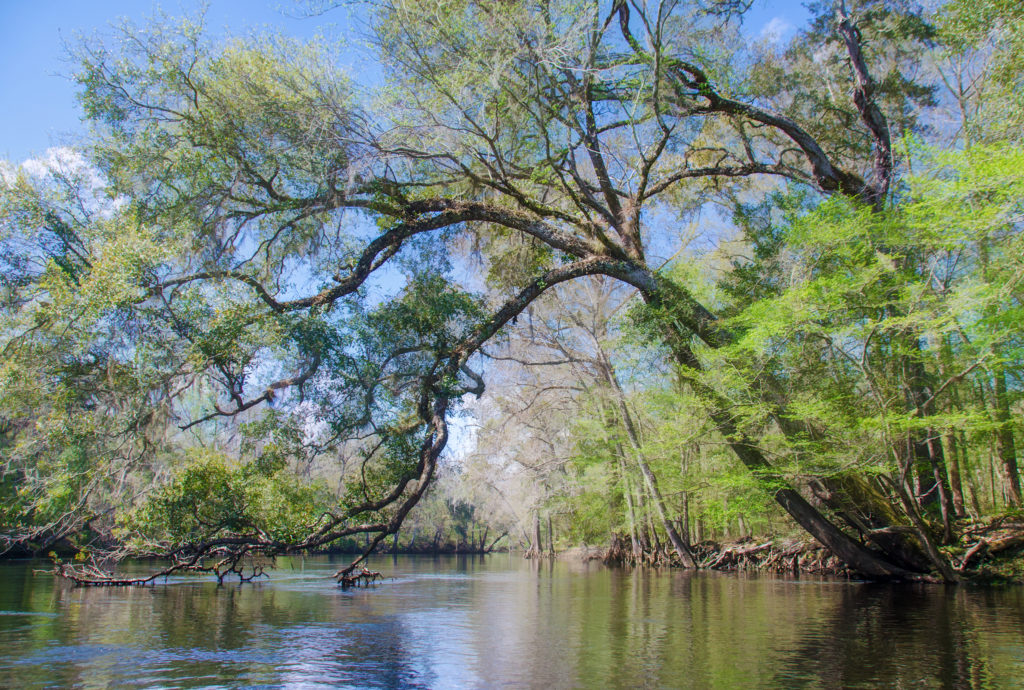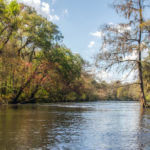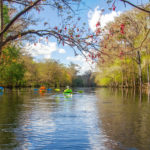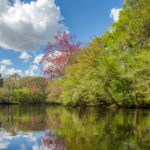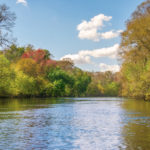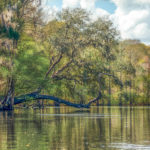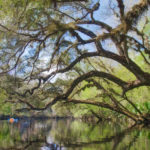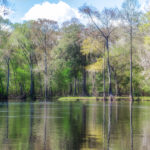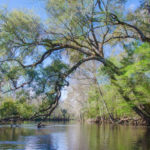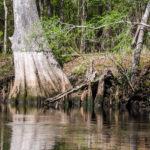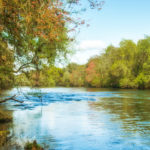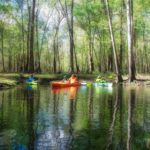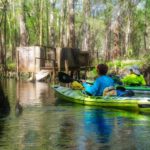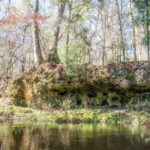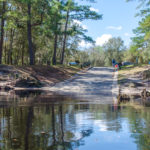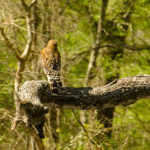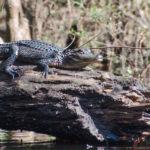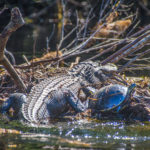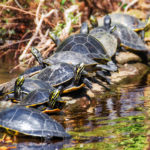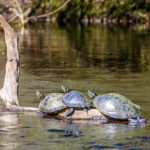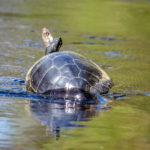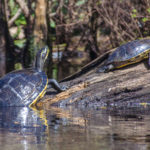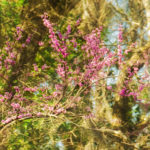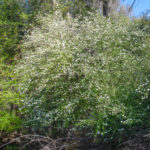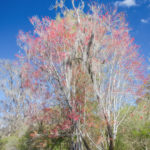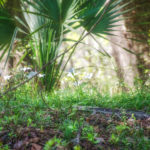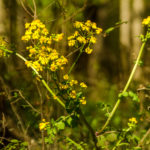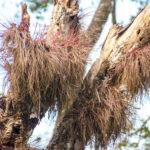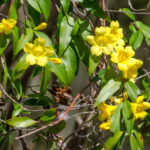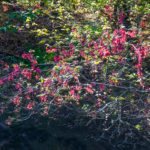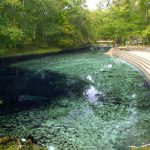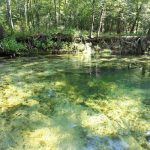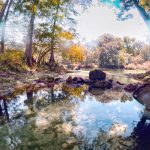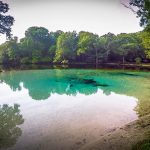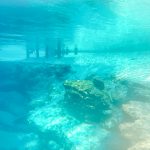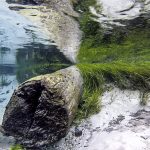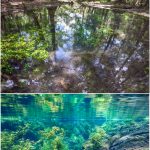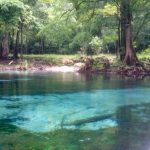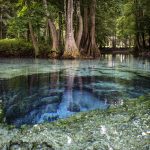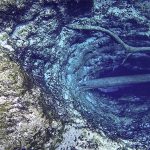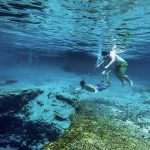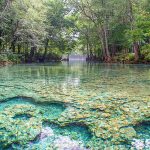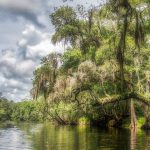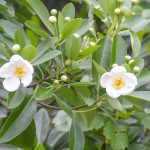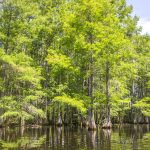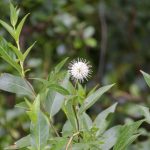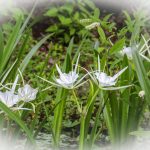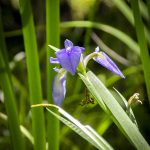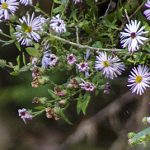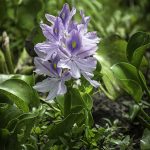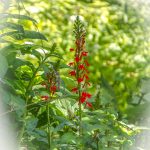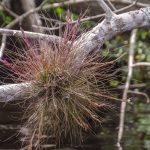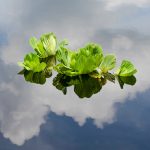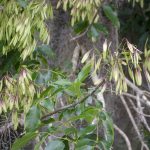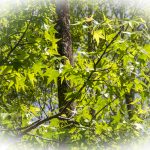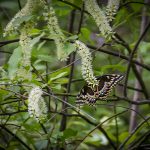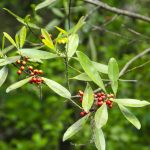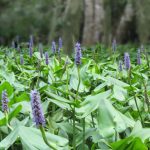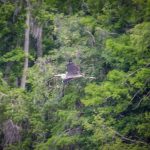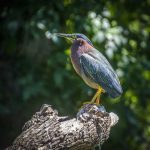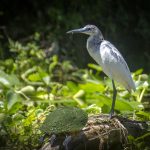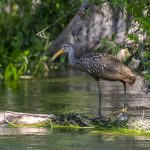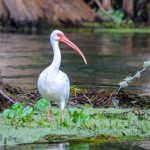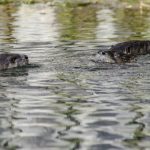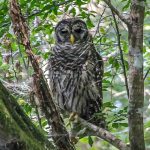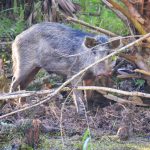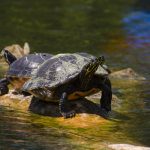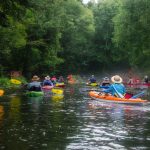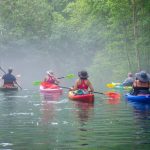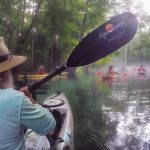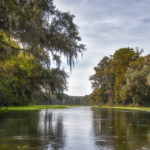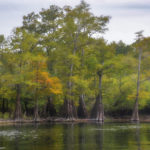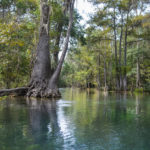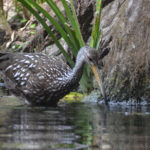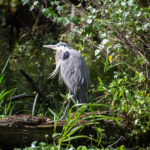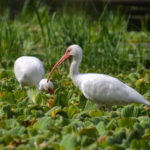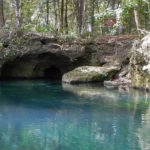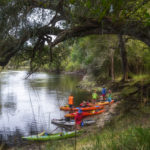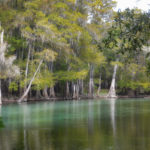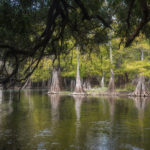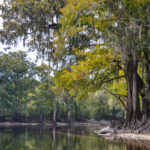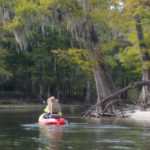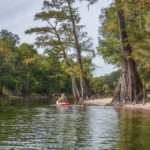Santa Fe River Overview

The Santa Fe River is a 75-mile river in north central Florida and derives its name from a Franciscan mission named Santa Fé de Toloca once located near the river. It’s source is Lake Santa Fe – Little Lake Santa Fe located north of Melrose and East of Waldo. The upper half of The Santa Fe is a small, winding creek that often dries in low water periods and the river is usually a slow-flowing river. Tannic acid, released from the roots of the cypress trees, leaves and organic matter, give the Santa Fe River a dark, tea-colored appearance.
The tributaries of the Santa Fe include the New River, Olustee Creek, and the Ichetucknee River. The Santa Fe flows into the Suwannee River near Branford, Florida. An interesting aspect of the river is that in it’s upper section, the river flows into a sinkhole at O’Leno State Park, flows underground for 3 miles then surfaces in River Rise Preserve State Park near High Springs.
Dozens of springs feed into the Santa Fe river many of which are located in what is called the Lower Santa Fe River. Some springs are small and have interesting stories as does Lily Spring once occupied by ’Naked Ed’ and the neighboring Packard Spring, whose tenants enjoy skinny dipping. Some of the most popular springs include Poe Springs, Rum Island Spring, Gilchrist Blue, Ginnie, Devils Eye and Devils Ear. Due to the numerous springs the water temperature is usually around 72 °F, especially close to the springs.
A 26 mile Designated Paddling Trail runs from High Springs to Branford at the Suwannee River. The upper portion of this stretch has the abundance of popular springs and after the Ichetucknee River flows into the Santa Fe the river widens. In this section there is more development and there are numerous powerboats as it flows into the Suwannee River.
The Santa Fe River has an abundance of wildlife to include several species of Turtles, Otters, Deer, Snakes, Herons, Egrets, Limpkins, Owls and Ospreys among others. Along the shoreline is an assortment of hardwood trees and in the lower-lying areas there are a variety of shrubs to include Spider Lilies, Atamasco Lilies, Buttonbush, Red Cardinal Flower, Yellow Burr Marigolds and Purple Asters.
![]()
Upper Santa Fe River – Olustee Creek | Upper Santa Fe River & Sink | Upper Santa Fe River US – Hwy 441/41 to River Rise | HWY 41 to Rum Island | | US Hwy 27 to Rum Island | Rum Island to Hwy 47 | Santa Fe River at Ichetucknee & Hwy 129

Upper Santa Fe River to Olustee Creek Details
![]() Location: The Upper Santa Fe River is considered that section of the river both upstream and downstream for Worthington Springs…(Upper Santa Fe River map).
Location: The Upper Santa Fe River is considered that section of the river both upstream and downstream for Worthington Springs…(Upper Santa Fe River map).
![]() Launch point and Take out: The launch and take for this paddle is Bible Camp Road Boat Launch, located at the end of Bible Camp Road, High Springs, 32643.
Launch point and Take out: The launch and take for this paddle is Bible Camp Road Boat Launch, located at the end of Bible Camp Road, High Springs, 32643.
![]() Paddle Distance: 6.8 miles, includes a look around at Santa Fe Spring.
Paddle Distance: 6.8 miles, includes a look around at Santa Fe Spring.
![]() Difficulty: Easy…however at low water levels, accessibility may present a problem! Today the water level was about the same level as back in February.
Difficulty: Easy…however at low water levels, accessibility may present a problem! Today the water level was about the same level as back in February.
 Average Paddle Speed: 2.00 mph.
Average Paddle Speed: 2.00 mph.
![]() Width and Depth: The Santa Fe River, at the launch is around 150′ wide, narrowing to 75′ at the confluence to Olustee Creek. Olustee Creek begins with an 85′ opening but quickly narrows to a winding 20′ wide. The depth of both waterways was quite shallow, the Santa Fe, under 4′ and in sections, 2′, while Olustee Creek was at most 2′ deep and at a couple of spots, a mere 6″.
Width and Depth: The Santa Fe River, at the launch is around 150′ wide, narrowing to 75′ at the confluence to Olustee Creek. Olustee Creek begins with an 85′ opening but quickly narrows to a winding 20′ wide. The depth of both waterways was quite shallow, the Santa Fe, under 4′ and in sections, 2′, while Olustee Creek was at most 2′ deep and at a couple of spots, a mere 6″.
![]() Current – Tidal: Current, very slow-moving
Current – Tidal: Current, very slow-moving
![]() Side Paddles: At mile marker 1.6 there is a lagoon on river left that is about a 1/4 mile long. We explored this back in February and decided to pass on this paddle. Around mile 2.3 on RL is the entrance to Santa Fe Spring, which we entered the 125′ run and explored this spring. At mile 2.78 Olustee Creek enters the river. In Feb. we were able to paddle up about 0.33 mile and due to the low water, we decided to turn back. Today we were able to get up 0.42 miles before coming to a large exposed rock island. Less than 50′ past this rock was a definite blockage of trees, so we turned around here.
Side Paddles: At mile marker 1.6 there is a lagoon on river left that is about a 1/4 mile long. We explored this back in February and decided to pass on this paddle. Around mile 2.3 on RL is the entrance to Santa Fe Spring, which we entered the 125′ run and explored this spring. At mile 2.78 Olustee Creek enters the river. In Feb. we were able to paddle up about 0.33 mile and due to the low water, we decided to turn back. Today we were able to get up 0.42 miles before coming to a large exposed rock island. Less than 50′ past this rock was a definite blockage of trees, so we turned around here.
![]() Rest Areas: There are no bathroom facilities at the launch but there are several secluded spots there as well as along the river to rest and heed nature’s call if need be.
Rest Areas: There are no bathroom facilities at the launch but there are several secluded spots there as well as along the river to rest and heed nature’s call if need be.
Upper Santa Fe River – Olustee Creek Paddle Map
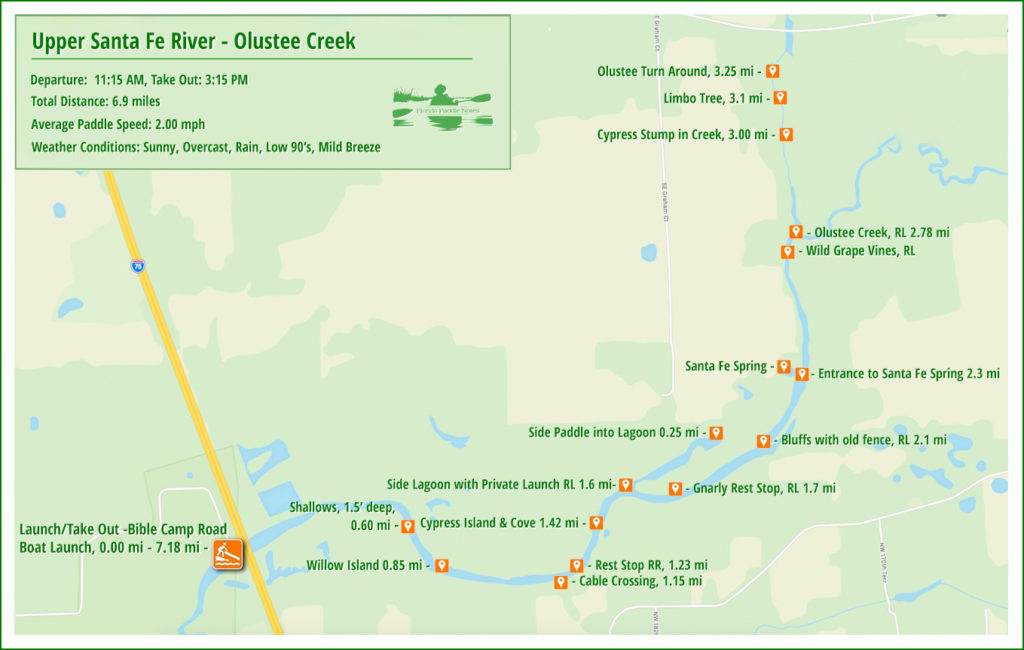
Bible Camp Road Launch
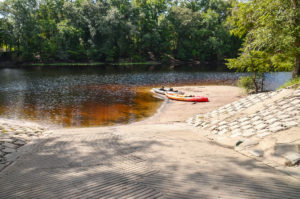
Bible Camp Road Boat is at the end of nowhere. Just keep on driving until the road ends at I-75. The launch is very nice. Spacious, with a concrete ramp and a large sandy area for a soft launch or staging. There is ample parking but no restroom facilities. There is no fee to launch here.
The Upper Santa Fe River

We head upriver, paddling under I-75. The water is low and the twisted roots of Cypress and Swamp Tupelo are exposed along the banks. Despite paddling upriver the current is minimal and not a problem.
It’s a pleasant paddle and along the way, we pass a couple of exposed islands, perfect for rest stops or picnics. Nice white sandy beaches, shallow water, and plenty of large Willows. In fact, there were numerous willows all along this section of the river to complement the Bald Cypress and Tupelos.
Santa Fe Spring
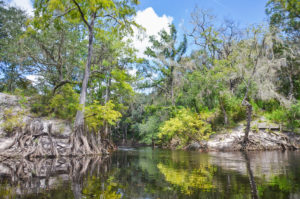
Santa Fe Spring is always worth a visit. At mile marker 2.3, the spring run is visible on river left flowing through tall sandy banks, with the ruins of an old residence on the right bank. The water was flowing quite strongly through the narrow 100′ run and once inside, we found ourselves in a 200′ diameter circular pool. The banks were steep, lined with Oaks, Pine, and Cypress. The boil of this 1st magnitude spring is located in the NW side of the pool, however, there is no sign on the surface of a boil and the pool is basically dark. Once inside the spring pool, there is a nice sandy beach to relax and cool off in the water. See the spring details here.

Olustee Creek
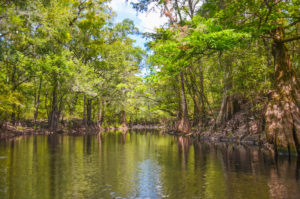
Olustee Creek is one of the main tributaries to the Santa Fe River. It is a slow-moving, twisting creek, lined with cypress trees and bay. Olustee Creek is famous as the location of the largest battle of the Civil War fought in Florida, The Battle of Olustee. On February 20, 1864, the Confederate army repulsed the Union army forcing a retreat to Jacksonville.
We reached the confluence at mile marker 2,78, river left. The opening was wider than the actual Santa Fe River, however, 85′ was reduced to 20′ less than 300′ into the creek. It was shallow, winding, and interesting. The creek ranged from a couple of feet deep to 6″ deep, with a very hard rock bottom and a lot of debris. A 1/4 mile up the creek is a stump in the middle, followed by a ‘limbo tree” 550′ further on. In February this is where we turned around due to the tree and low water, however today, we were under the tree and were able to paddle another 300′ before reaching a large rock formation that blocked the creek. We rested here and thought about an easy portage, however, just another 50’ further was a definite main blockage of trees and stumps and debris. I’ll let someone else explore beyond the blockage. Here we turned around and headed back to the Santa Fe.
Santa Fe River & Sink Details
The Upper Santa Fe River flows in a southwesterly direction from Bible Camp Road Boat Launch where 2.75 miles downstream, it eventually sinks underground at O’Leno State Park. The river continues flowing underground for a little over three miles before emerging in River Rise State Park. The geology of the Santa Fe River basin features Karst Limestone formation which produces many of the springs found along the river and for also creating this three-mile underground tunnel in which the Santa Fe flows. The area above the river, as it flowed underground, was used for thousands of years as a natural bridge to travel across the river, and is part of the Old Bellamy Road. There are links following this post with information for further reading.
![]() Location: The Upper Santa Fe River is considered that section of the river both upstream and downstream for Worthington Springs…(Upper Santa Fe River map).
Location: The Upper Santa Fe River is considered that section of the river both upstream and downstream for Worthington Springs…(Upper Santa Fe River map).
![]() Launch point and Take out: The launch and take for this paddle is Bible Camp Road Boat Launch, located at the end of Bible Camp Road, High Springs, 32643. If you have two vehicles, one could be left at O’Leno St. Park which would eliminate the return paddle over the shoal.
Launch point and Take out: The launch and take for this paddle is Bible Camp Road Boat Launch, located at the end of Bible Camp Road, High Springs, 32643. If you have two vehicles, one could be left at O’Leno St. Park which would eliminate the return paddle over the shoal.
![]() Difficulty: Easy to Hard, depending on the water level. Today’s paddle exposed a shoal that was no problem on the way downstream but required some portaging coming back over the shoal. As mentioned above, if you have two vehicles, one could be left at O’Leno St. Park which would eliminate the return paddle over the shoal.
Difficulty: Easy to Hard, depending on the water level. Today’s paddle exposed a shoal that was no problem on the way downstream but required some portaging coming back over the shoal. As mentioned above, if you have two vehicles, one could be left at O’Leno St. Park which would eliminate the return paddle over the shoal.
 Average Paddle Speed: 2.00 mph.
Average Paddle Speed: 2.00 mph.
![]() Width and Depth: The Santa Fe River, at the launch is around 150′ wide, narrowing to 50 – 75′ the remaining distance. The depth at the launch was well over 7′ ( 38′ (NAVD88). Other sections were more shallow, some around 1.5′ deep.
Width and Depth: The Santa Fe River, at the launch is around 150′ wide, narrowing to 50 – 75′ the remaining distance. The depth at the launch was well over 7′ ( 38′ (NAVD88). Other sections were more shallow, some around 1.5′ deep.
![]() Current – Tidal: Current, was mild except over the shoal which was very strong.
Current – Tidal: Current, was mild except over the shoal which was very strong.
![]() Rest Areas: There are no bathroom facilities at the launch but there are several secluded spots there as well as along the river to rest and heed nature’s call if need be. There are facilities at O’Leno St. Park.
Rest Areas: There are no bathroom facilities at the launch but there are several secluded spots there as well as along the river to rest and heed nature’s call if need be. There are facilities at O’Leno St. Park.
Upper Santa Fe River & Sink Paddle Map
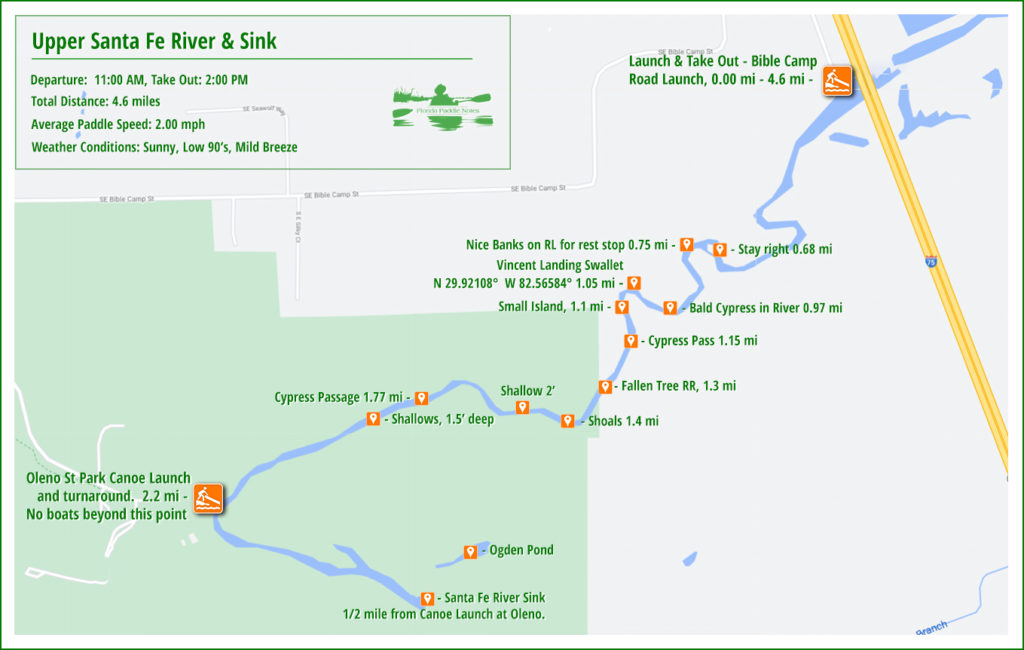
Bible Camp Road Launch
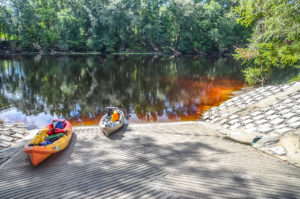
Bible Camp Road Boat Launch is at the end of nowhere. Turning right off of Hwy 41 just past the entrance to O’Leno St. Park, drive 3.4 miles east until the road ends at I-75. The launch is very nice. Spacious, with a concrete ramp and a large sandy area for a soft launch or staging. There is ample parking but no restroom facilities. There is no fee to launch here.
What a difference a week makes! The water level was about 14″ higher today then it was in last week’s paddle. This definitely made for an enjoyable paddle that otherwise might have required portaging.
Paddling Downstream
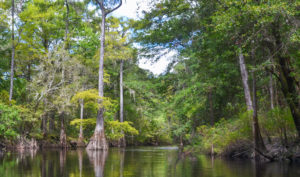
After passing a few ‘sandbar’ type islands covered with Willows, we soon had a wonderful canopy of River Birch overhead. The six-foot-high banks were lined with Bald Cypress knees from the many cypresses that bordered this paddle. What was most notable was the extraordinary amount of River Birch trees along this entire section! From the shoreline, they stretched out and leaned over the river and in many sections created picturesque and cooling canopies.
By the time we reached the one-mile mark, Cypress trees were appearing in mid-river and creating small islands and passages that added to a beautiful ambiance. River Birch, Bald Cypress, American Elm, and Oaks where the predominant trees, while along the left bank, Saw Palmettos and Shrubby St. John’s Wort were a visible understory. Peppervine hung from the Birch branches. Wildlife was sparse, save for a few turtles, one young alligator, and a couple of Great White Egrets, that flew along ahead of us the entire way, stopping, waiting for us to catch up and then flying further ahead. Notable here, at mile 1.05, RR, is a small cove known as Vinzant Landing, the location of Vinzant Swallet, however, we were not able to view the swallet.
The Shoals
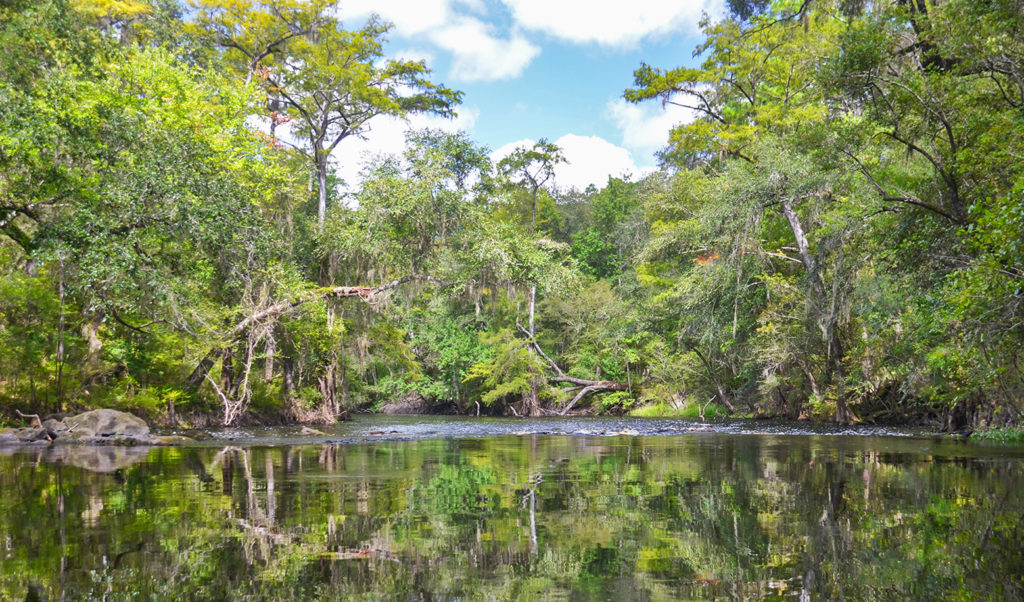
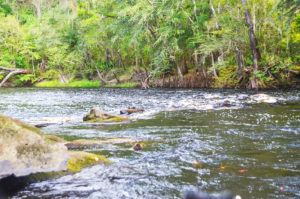
At mile 1.4, just around a corner, is the shoal. It can be heard several hundred feet ahead, but not seen until after a small bend in the river. Along the left bank are several large, exposed rocks that provide a place to stop, and observe the best way to paddle the shoal. The water is moving quite fast through here, however, the route is obvious. Following the smooth “V” at center-right, we went through quickly, stayed to our right, and then followed through back to the center of the river. A quick thrill to add to this enjoyable paddle.
We did not dwell on how we would get over the shoal on our return! ***If you have two vehicles, one could be left at O’Leno St. Park which would eliminate the return paddle over the shoal.
O’Leno State Park & The Sink
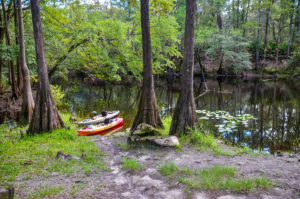
Continuing on after the shoal, the River Birch canopy continues. To our left, Pines are visible up and beyond the higher bank. Along this ridge are numerous Saw Palmetto and Shrubby St. Johns Wort. To the right, the bank is lower with more numerous cypress knees and trees. A good stretch of this section is shallow and no more than a foot and a half over the rock bottom.
In less than a mile from the shoal, we reach the end of the line, O’Leno St. Park. Here there is a buoyed roped across the river and signs indicating “No Boats Beyond this Point“. It is a beautiful park. This endpoint is the canoe rental area and the swimming area, with a nice platform. The river continues under the suspension bridge built by the Civilian Conservation Corp in 1938, flows over another shoal, and enters it’s underground journey one-half mile downstream. We stop, have lunch, and relax before heading back.
![]() At this water level, it is an awesome, relatively short paddle with great scenery. As mentioned above, in the details on difficulty, it could be a challenge for some getting back over the shoal. The water was just too strong to paddle up over the same place we went down. The right side requires portaging over the rocks. We chose the left side, exiting our kayaks, and using our tow ropes, walked our kayaks about twenty feet, in the water along the bank. We then entered once past the main current into the shoal and continued our paddle back. As mentioned above, if you have two vehicles, one could be left at O’Leno St. Park which would eliminate the return paddle over the shoal.
At this water level, it is an awesome, relatively short paddle with great scenery. As mentioned above, in the details on difficulty, it could be a challenge for some getting back over the shoal. The water was just too strong to paddle up over the same place we went down. The right side requires portaging over the rocks. We chose the left side, exiting our kayaks, and using our tow ropes, walked our kayaks about twenty feet, in the water along the bank. We then entered once past the main current into the shoal and continued our paddle back. As mentioned above, if you have two vehicles, one could be left at O’Leno St. Park which would eliminate the return paddle over the shoal.
Santa Fe River Rise Details
37 miles West of this source, the Santa Fe River disappears into a large sinkhole located in O’Leno State Park. The river continues to flow, underground, until it emerges 3 miles SSW of O’Leno in what is now River Rise Preserve State Park. The River Rise has an abundance of wildlife to include several species of Turtles, Otters, Deer, Snakes, Herons, Egrets, Limpkins, Owls, and Ospreys among others. The shoreline, adorned with numerous Cypress Knees, is an assortment of hardwood trees and Saw Palmetto.
![]() Location: The ‘River Rise’ is located in Alachua County in the River Rise Preserve State Park.
Location: The ‘River Rise’ is located in Alachua County in the River Rise Preserve State Park.
![]() Launch/Take Out Point for this paddle: The launch is located at the High Springs Boat Ramp, 25227 Boat ramp Rd, High Springs, FL 32643. Rentals are available at Santa Fe Canoe Outpost High Springs, just up the road/river from the launch and Adventure Outpost in downtown High Springs.
Launch/Take Out Point for this paddle: The launch is located at the High Springs Boat Ramp, 25227 Boat ramp Rd, High Springs, FL 32643. Rentals are available at Santa Fe Canoe Outpost High Springs, just up the road/river from the launch and Adventure Outpost in downtown High Springs.
![]() Paddle Distance: Approximately 5.5 miles round trip.
Paddle Distance: Approximately 5.5 miles round trip.
![]() Difficulty: Easy. Today there was a strong current at the launch on the Santa Fe River, but an easy, relaxing paddle up and back.
Difficulty: Easy. Today there was a strong current at the launch on the Santa Fe River, but an easy, relaxing paddle up and back.
![]() Width and Depth: The width of the Santa Fe was 170′ at the launch and 135′ at the River Rise. In between, there were minimum widths of 40′ and 90′. At the launch, the depth was 2-3′ and naturally deeper by the time we reached the Rise, however, along the way there were sections just over one foot deep. The flood stage for this area is 36′ and the water level today was at 32.3′.
Width and Depth: The width of the Santa Fe was 170′ at the launch and 135′ at the River Rise. In between, there were minimum widths of 40′ and 90′. At the launch, the depth was 2-3′ and naturally deeper by the time we reached the Rise, however, along the way there were sections just over one foot deep. The flood stage for this area is 36′ and the water level today was at 32.3′.
![]() Current – Tidal: The current was swift at the launch but quickly mellowed out. Even though we were paddling upstream, there were areas of minimal resistance and a slow steady pace on the return.
Current – Tidal: The current was swift at the launch but quickly mellowed out. Even though we were paddling upstream, there were areas of minimal resistance and a slow steady pace on the return.
![]() Side Paddles: Side paddles are not applicable on this portion of the river, although there are a couple of springs to pass that were not clearly visible. ( See paddle map )
Side Paddles: Side paddles are not applicable on this portion of the river, although there are a couple of springs to pass that were not clearly visible. ( See paddle map )
![]() Rest Areas: Rest areas available at the launch as well as at the rise. Along the river there are areas to come ashore for a break. There is access to Santa Fe Canoe Outpost on the southeast side of the Hwy 41 Bridge.
Rest Areas: Rest areas available at the launch as well as at the rise. Along the river there are areas to come ashore for a break. There is access to Santa Fe Canoe Outpost on the southeast side of the Hwy 41 Bridge.
The Santa Fe River Rise Paddle Route
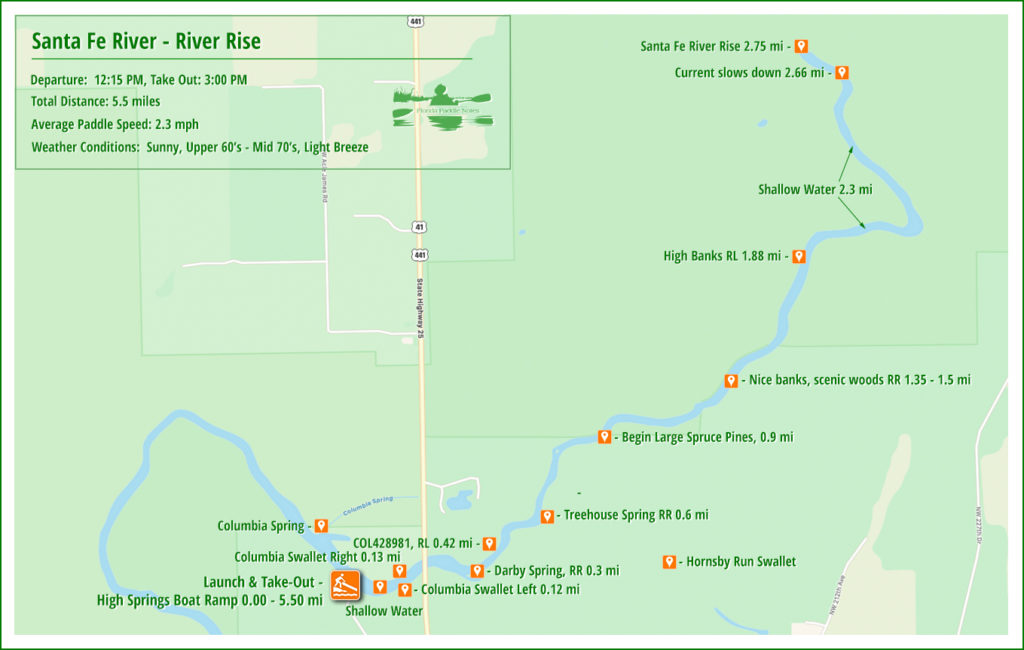
High Springs Boat Ramp

The High Springs Boat Ramp is located at 25227 Boat ramp Rd, High Springs, FL 32643. The High Springs Boat Ramp (and surrounding property) was purchased in 1958 from the State of Florida to provide recreational access to the Santa Fe River.
It is a bit of a slope for hauling kayaks but a good concrete ramp. Boats can be staged on either side of the ramp in the shallow, lime rock and sand bottom water.
The ramp is on the southern side of a large bend in the river creating a swift current coming from upstream to downstream. There is a rocky shoal just downstream from the launch.
Swallets and Springs
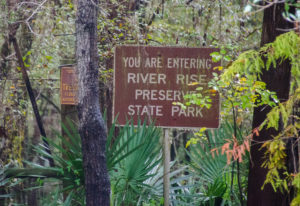
The current at the launch was swift but not long-lasting and by the time we went through the first major bend, it was easy going.
This section of the Santa Fe is absolutely gorgeous. The fall colors were just beginning to appear. The banks displayed a wide variety of trees to include several species of Oaks, Bald Cypress, Maples, and Gum. One interesting observation was the stands of large Spruce Pine, which, in some spots were quite tall.
There were only a few areas with Water Hyacinth, the shoreline was mostly clear of aquatic plants. Like small sentinels, Cypress Knees lined the shoreline for the entire paddle. With water level around five feet below flood stage ( 36′ ) the 2′ – 6′ banks were evident on both sides of the river topped with very vibrant Saw Palmettos.
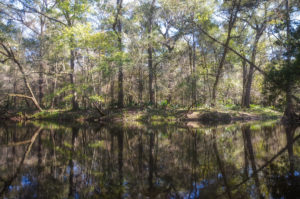
This paddle takes you past a couple of Swallets and two Springs, Darby Spring and Treehouse Spring, The two swallets are in small pockets across from each other just before reaching the Hwy 441 Bridge. ( see the paddle map for locations ). We did not paddle into Darby Spring. It is covered with branches, debris, and located on private property. Treehouse Spring is located in a small cove on the right but was not clear. It also is surrounded by private property.
River Rise
River Rise is where the Santa Fe River emerges from its three-mile journey underground from O’Leno State Park. This paddle to the rise takes you over some very shallow water and if the water level was one foot less, I am sure there would be portaging in some areas. Once at River Rise, I am always surprised that for such a large body of water emerging from underground, there is very little motion on the surface to indicate just what an amazing natural occurrence is taking place below us! It is a great place to enjoy and a nice view…
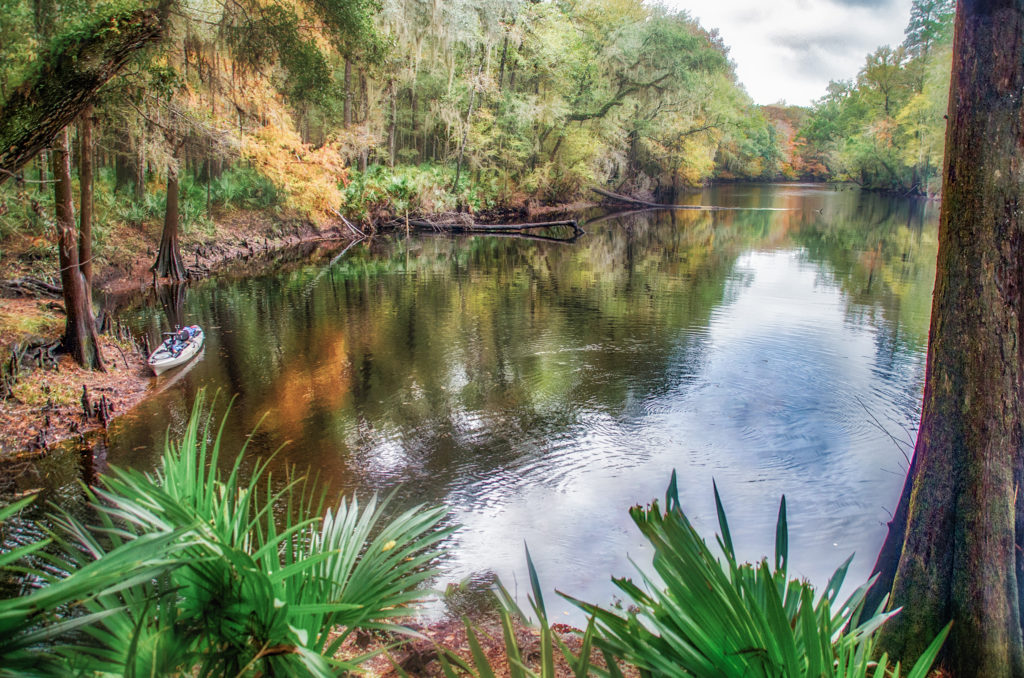
Hwy 41 to Rum Island Details
![]() Location: The ‘River Rise’ is located in Alachua County in the River Rise Preserve State Park.
Location: The ‘River Rise’ is located in Alachua County in the River Rise Preserve State Park.
![]() Launch Point for this paddle: The launch is located at the High Springs Boat Ramp, 25227 Boat ramp Rd, High Springs, FL 32643. Rentals are available at Santa Fe Canoe Outpost High Springs, just up the road/river from the launch and Adventure Outpost in downtown High Springs.
Launch Point for this paddle: The launch is located at the High Springs Boat Ramp, 25227 Boat ramp Rd, High Springs, FL 32643. Rentals are available at Santa Fe Canoe Outpost High Springs, just up the road/river from the launch and Adventure Outpost in downtown High Springs.
Take Out: The take-out point for this paddle is at Rum Island County Park. Take US 27 NW out of High Springs for 3.3 miles from downtown. Turn left on CR 138 and travel 2 miles. Turn left on Rum Island Road and travel 1.5 miles to the park and launch.
![]() Paddle Distance: Approximately 8.3 miles.
Paddle Distance: Approximately 8.3 miles.
![]() Difficulty: Easy. Today there was a nice current allowing for an easy, relaxing paddle.
Difficulty: Easy. Today there was a nice current allowing for an easy, relaxing paddle.
 Average Paddle Speed: 2.7mph.
Average Paddle Speed: 2.7mph.
![]() Width and Depth: The width of the Santa Fe was 170′ at the launch. In between there were minimum widths of 40′ and 90′. The water level at the launch was 32′. Flood stage for this area is 35′.
Width and Depth: The width of the Santa Fe was 170′ at the launch. In between there were minimum widths of 40′ and 90′. The water level at the launch was 32′. Flood stage for this area is 35′.
![]() Current – Tidal: The current was steady flow, 2+ mph.
Current – Tidal: The current was steady flow, 2+ mph.
![]() Side Paddles: Side paddles were taken at Poe Springs, Pickard Springs and Gilchrist Blue Springs ( see Paddle Map ).
Side Paddles: Side paddles were taken at Poe Springs, Pickard Springs and Gilchrist Blue Springs ( see Paddle Map ).
![]() Rest Areas: Rest areas could be found along this paddle if exiting the boat was necessary. Actual facilities can be found at Poe Springs, Gilchrist Blue and Rum Island Park.
Rest Areas: Rest areas could be found along this paddle if exiting the boat was necessary. Actual facilities can be found at Poe Springs, Gilchrist Blue and Rum Island Park.
![]() Important Information: This is an easy going paddle, no warnings necessary. There are three small , short shoal areas with rocks and at a lower water levels may be tricky for some folks to paddle over the rocks.
Important Information: This is an easy going paddle, no warnings necessary. There are three small , short shoal areas with rocks and at a lower water levels may be tricky for some folks to paddle over the rocks.
Hwy 41 to Rum Island Paddle Map
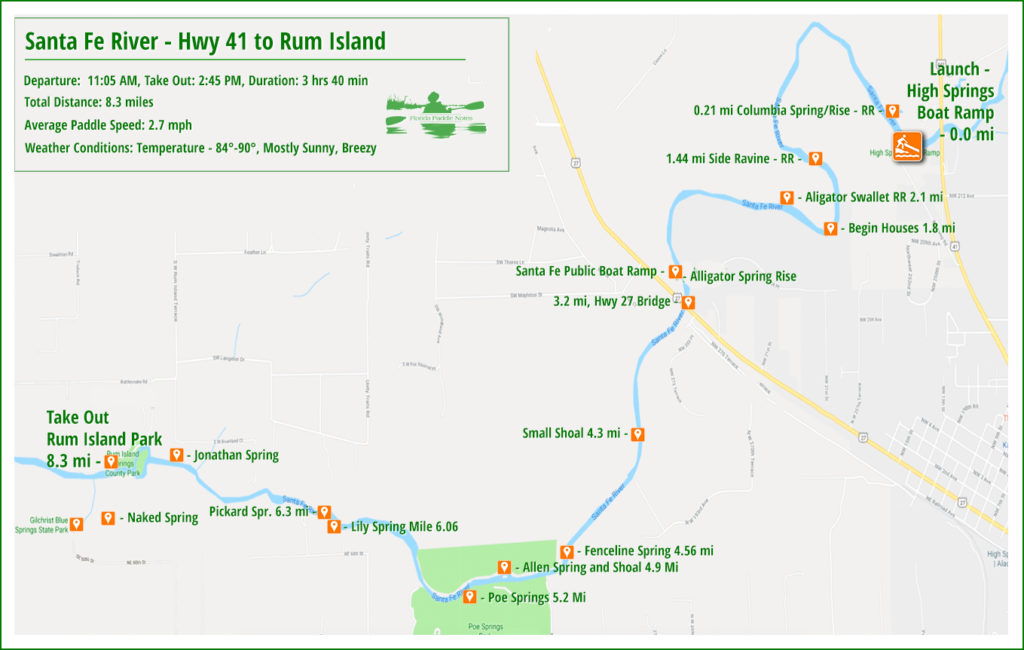
High Springs Boat Ramp

The High Springs Boat Ramp is located at 25227 Boat ramp Rd, High Springs, FL 32643. The High Springs Boat Ramp (and surrounding property) was purchased in 1958 from the State of Florida to provide recreational access to the Santa Fe River.
It is a bit of a slope for hauling kayaks but a good concrete ramp. Boats can be staged on either side of the ramp in the shallow, limerock and sand bottom water.The ramp is on the southern side of a large bend in the river creating a swift current coming from upstream to downstream.
Launching from the High Springs Boat Ramp, the temperature at 11:05 am was 82°, relatively warm for this time of year. It was mostly sunny, the river had a nice flow and the wind was at our backs. The initial shoal at launch is quick, over a shallow, rocky stretch for about 100′. At a lower water lever, there would definitely be exposed rocks. Currently the water level was at 32′ with flood stage being 35′ for this section. The water marks on the cypress along the shore bore evidence to this. Also, a 1/4 mile from the launch, on RR is Columbia Spring/Rise.
Hwy 41 to Hwy 27
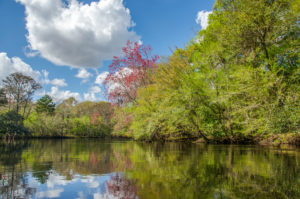 This section of the Santa Fe is one that should not be missed. Although it was near mid-February, this area has experienced only a few cold snaps. Along the river, trees and shrubs were displaying signs of an early Spring, with new flushes of light green foliage and showy blossoms. In bloom were Redbuds, Carolina Yellow Jasmine, Flatwoods/Chickasaw Plum and Walter’s Viburnum. Red Maples displayed their showy ‘Winged Samaras’, Elms were flushing with new growth. Many of the oaks, overhanging the river, displayed signs of a fresh new leafing out.
This section of the Santa Fe is one that should not be missed. Although it was near mid-February, this area has experienced only a few cold snaps. Along the river, trees and shrubs were displaying signs of an early Spring, with new flushes of light green foliage and showy blossoms. In bloom were Redbuds, Carolina Yellow Jasmine, Flatwoods/Chickasaw Plum and Walter’s Viburnum. Red Maples displayed their showy ‘Winged Samaras’, Elms were flushing with new growth. Many of the oaks, overhanging the river, displayed signs of a fresh new leafing out.
I have never seen Alligators on the Santa Fe River ( though I obviously know they are there ), however in this section, I photographed three gators and numerous turtles. The turtles were on every available perch or trunk above the high water and on one shot a gator and a turtle shared the same small island of debris.
This is a pleasant, easy beginning to the journey. The first 3 miles, which is the stretch between Hwy 41 and Hwy 27, forms a large “S” shape as it winds its way through the quiet, unpopulated landscape, a combination of flatwoods on one side and low swampland on the other. Deep ravines can be seen, mainly on RR along this section. At 2.1 miles, is Alligator Swallet, where water from the river goes underground and resurfaces several hundred feet down river. Approaching the 3 mile mark, just prior to the Bridge over HWY 27, is Alligator Spring/Rise on RR. All along this last section before the bridge, on RR, more deep ravines can be seen but are blocked by numerous cypress knees.
Hwy 27 to Poe Springs
This next 1.8 mile stretch takes us through three small shoals and a couple of smaller springs often not seen. Many of the trees that were blooming on the first stretch were not as noticeable on this section. What was eye catching where the numerous oaks that leaned over the river from the banks creating scenic arches to paddle beneath.
Just after reaching the 4 mile mark of the trip, we paddle under a power line that also has a minimal shoal. Continuing on a straight course, another shoal appears 1/4 mile down river. Around mile marker 4.57 is a small island and on RL is what is known as Fenceline Spring ( ALA903971). This spring is actually in the river bed and at our water level today goes unnoticed.
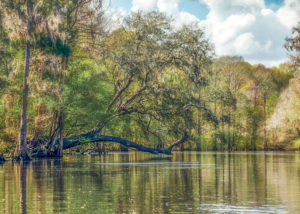
Under a half mile further there is an island, with small shoals and on RR, at the island is Allen Spring, small and unnoticed at high water levels. Ahead, just after 5 miles, is the familiar Poe Springs tree, that reaches out from RL marking the entrance to Poe Springs. The springs was not quite clear, a few visible sandy spots below, but a good chance to rest before moving on to Lily and Pickard Spring.
The Final Stretch
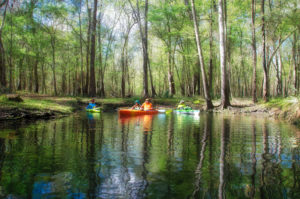
There was 2 1/4 miles to go, the day was still beautiful but actually getting close to 90° by now. Lily Springs, with bygone memories of the days of Naked Ed, is now a remnant of the structure he once greeted folks from. Pickard Spring, just around the corner from Lily was actually accessible but nothing exciting at this water level. From there we headed down river to Gilchrist Blue Spring.
On the way to Blue Spring, Jonathan Spring is on RR and had several occupants. This is a pleasant small spring to relax in on hot afternoon!
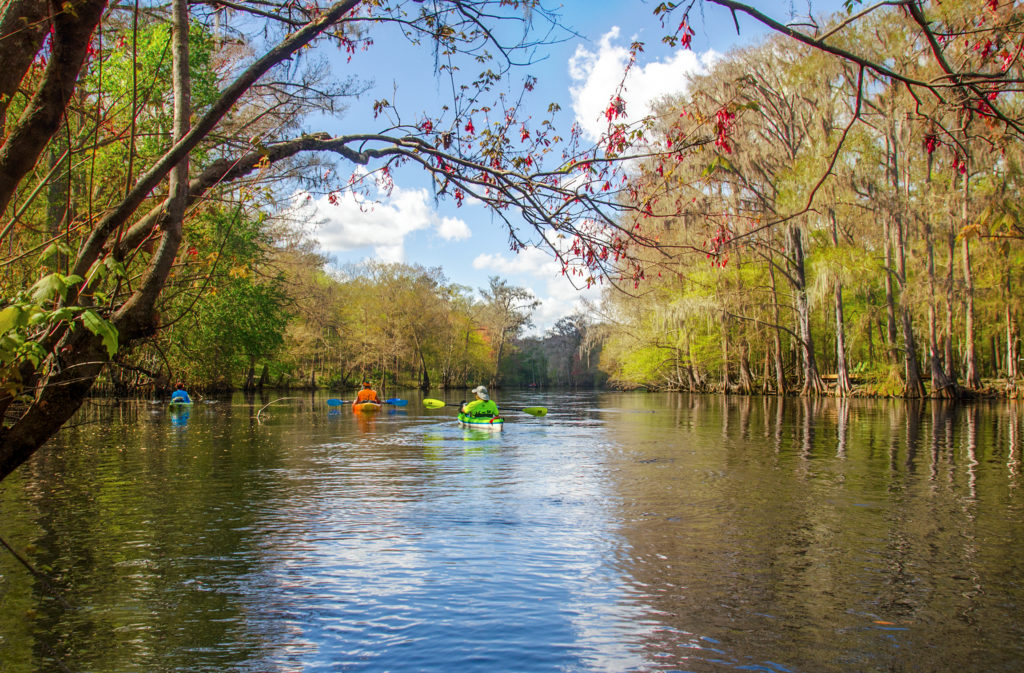
Gilchrist Blue Spring is just past Rum Island Spring, (which was browned out). Being a 2nd magnitude spring, pumping 44 million gallons of water a day, it was clear and blue. On the run up to the Springs, we normally take a side paddle into Naked Spring, however trees block the run into the spring. A brief rest and snorkeling in Blue, then ending our paddle at Rum Island County Park, just across the river and ending another chapter of Florida Paddle Notes.
Santa Fe River Gallery
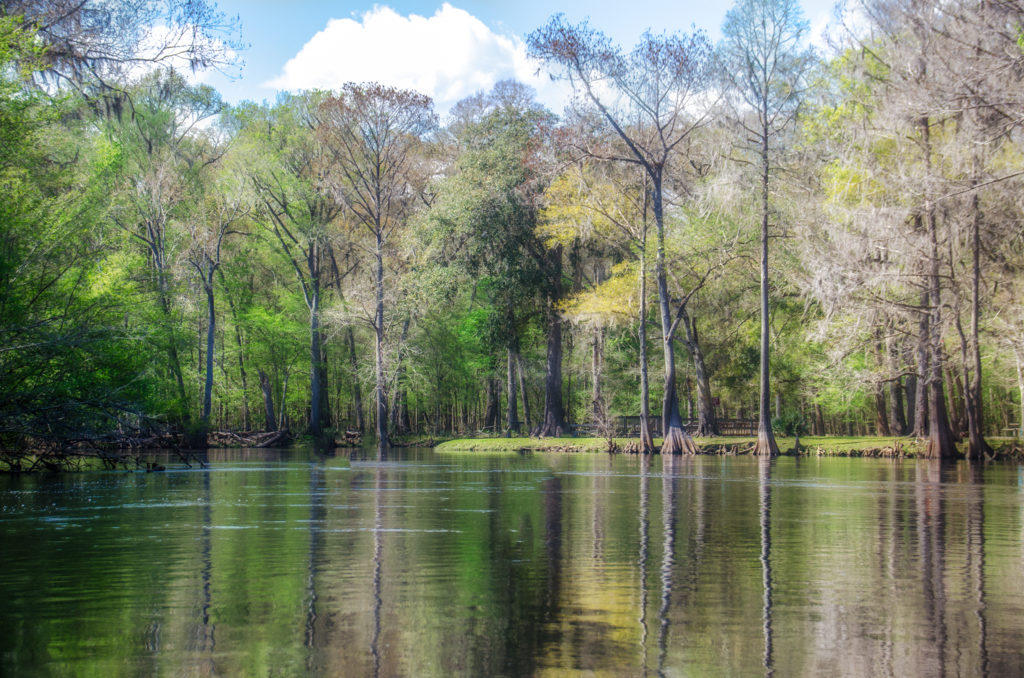
HWY 27 to Rum Island River Details
![]() Location: This paddle starts on HWY 27, 2.4 miles NW of High Springs, over the bridge and the launch is on the North side of the highway. There is plenty of parking.
Location: This paddle starts on HWY 27, 2.4 miles NW of High Springs, over the bridge and the launch is on the North side of the highway. There is plenty of parking.
![]() Launch points: The launch is 2.4 miles NW of downtown High Springs, over the bridge on the North side of Highway 27. There is plenty of parking.
Launch points: The launch is 2.4 miles NW of downtown High Springs, over the bridge on the North side of Highway 27. There is plenty of parking.
![]() Paddle Distance: This paddle is 7.7 miles. It is 5.8 miles from Hwy 27 to Sawdust Spring, then, heading back upstream it is another 1.9 miles to the take out at Rum Island County Park.
Paddle Distance: This paddle is 7.7 miles. It is 5.8 miles from Hwy 27 to Sawdust Spring, then, heading back upstream it is another 1.9 miles to the take out at Rum Island County Park.
![]() Difficulty: Easy to moderate. The river is open with a nice easy flow. I say moderate only if water levels are low as there may be shoals and rocks.
Difficulty: Easy to moderate. The river is open with a nice easy flow. I say moderate only if water levels are low as there may be shoals and rocks.
 Average Paddle Time: On this particular trip the paddle speed was about 2.3 mph. On a straight paddle with no stops it should take around 3.5 hours, however this trip is made for stopping and exploring the many springs, which could add several more hours to the trip.
Average Paddle Time: On this particular trip the paddle speed was about 2.3 mph. On a straight paddle with no stops it should take around 3.5 hours, however this trip is made for stopping and exploring the many springs, which could add several more hours to the trip.
![]() Width and Depth: The river is about 120′ wide at the start on Hwy 27 and gradually widens. At the turn around, Sawdust Springs, it is about 160′ wide. Average depth could vary depending on the water levels, from 2-3′ to 20′.
Width and Depth: The river is about 120′ wide at the start on Hwy 27 and gradually widens. At the turn around, Sawdust Springs, it is about 160′ wide. Average depth could vary depending on the water levels, from 2-3′ to 20′.
![]() Current – Tidal: The flow is approximately 1.5 – 2.+ mph. Not tidal. Just passed Ginnie Springs, depending on the water level, are some quick, fun shoals.
Current – Tidal: The flow is approximately 1.5 – 2.+ mph. Not tidal. Just passed Ginnie Springs, depending on the water level, are some quick, fun shoals.
![]() Side Paddles: There are numerous side paddles on this section of the river. The side paddles are short as they lead to the many springs along the route.
Side Paddles: There are numerous side paddles on this section of the river. The side paddles are short as they lead to the many springs along the route.
![]() Rest Areas: There are numerous areas to stop and rest along this section of the river. Many of the larger springs have public restrooms available.
Rest Areas: There are numerous areas to stop and rest along this section of the river. Many of the larger springs have public restrooms available.
Hwy 27 to Rum Island Paddle Map
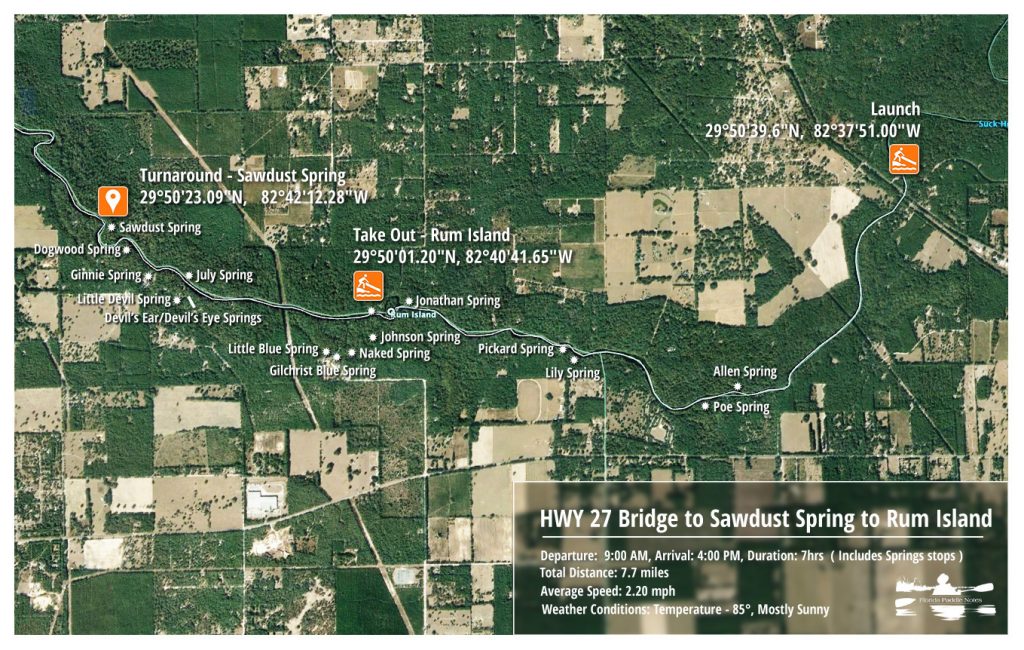
Fond Memories
Paddling the Santa Fe River is very special to me. I first saw the Santa Fe back in 1972 after purchasing 5 acres of land just up the road from Rum Island Spring. I spent many days on the Santa Fe exploring it’s numerous springs and each time I return there are fond memories. Back then, Rum Island Spring was not a county park and it was rarely used. On many days there were only a handful of locals there. Whenever my electricity would go out I walked down to the spring to cool off and just upstream a few hundred feet was Jonathan Spring, which I considered my private bathtub and spent many a hot summer day sitting in the small hidden spring!
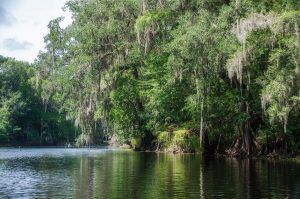
Leaving the launch and heading downstream under the old railroad trestle, the banks of the Santa Fe reach 10′-15′ high and gradually diminish in height by the time I reach Poe Springs, just under 2 miles downstream. Spotted houses line the banks and the shoreline is heavily wooded with Cypress and other assorted hardwoods. There was very little aquatic vegetation in this section on this particular paddle. The river had a slow gentle flow. Having stopped for a quick swim in Poe Springs, I paddled under the large live oak stretching over the water as I exit the spring head. I remember back, tying my canoe to the shoreline roots and climbing the oak just to sit and watch the river flow beneath me.
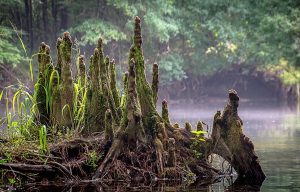
I refer to the Santa Fe River as a ‘lazy’ river. The slow moving current helps create a ‘no rush’ attitude while paddling or drifting along. The banks are full of hardwoods, shrubs and palmettos with many of the trees leaning over the shoreline offering a canopy of shade. When the water level is up and the flow is a bit more brisk, as on this trip, there is minimal aquatic vegetation along the shoreline until venturing into the spring runs. The banks are lined with numerous cypress knees acting like sentinels of the shoreline.
Naked Ed
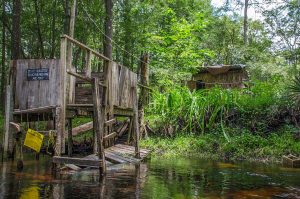
If you’ve paddled the Santa Fe you’ve probably saw or at least heard of Naked Ed. John Edward “Naked Ed” Watts has been the local Lily Springs caretaker for over 24 years and retired in 2017 due to illness and a need to care for his mother. Ed lived in a grass hut at the spring and as you guessed liked to be naked. A pleasant person, Ed liked greeting paddlers to Lily Spring from his deck over the water. Out of respect to visitors Ed would sometimes where a loin cloth or pants when he expected a crowd. Ed’s worst enemies were people who littered the springs and he kept Lilly Spring pristine. He’s been a legend over the years and doubtful he will return to the spring.
The Springs
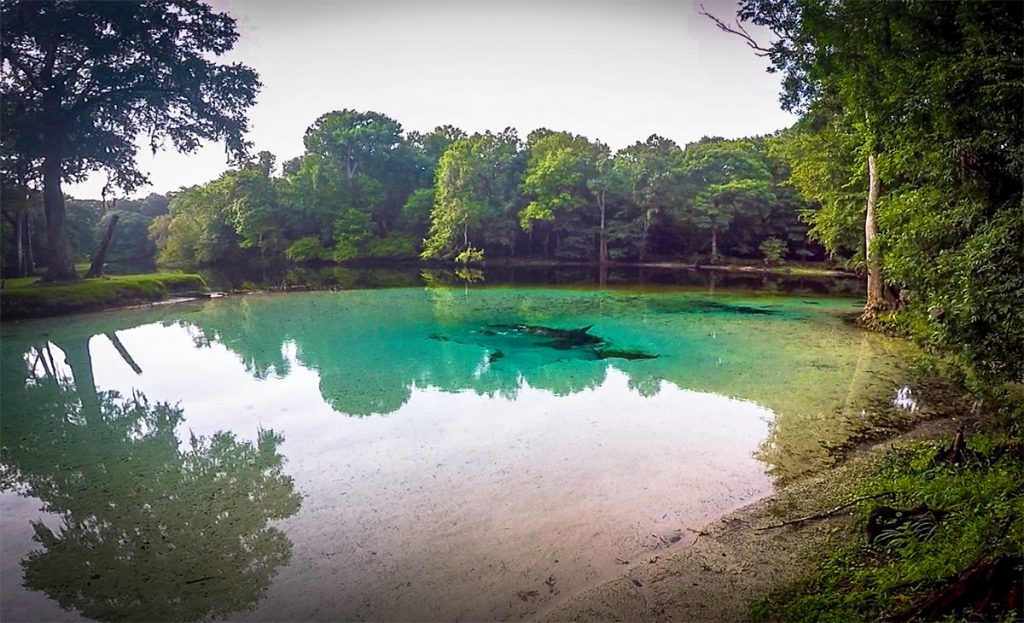
This stretch of the river is famous for it’s many springs. Though I have been to almost all of the springs on this section, this paddle only focuses on a select few… Individual spring details are noted in the highlighted spring links list below. For a more in depth look at location and descriptions, open the interactive springs map or look over several of the Maps and Guides listed above…
- Poe Spring ( 1.9 mi ) is usually my first stop and is always good for a refreshing swim, stretch and using the restroom. Poe Spring can get quite crowded on weekends. Depending on the water Levels, the shoals just downstream from Poe can be a quick fun run.
- Lily Spring is just under a mile downstream from Poe and was the home of ’Naked Ed’ . With a high water level, the water is swift up the short run.
- Packard Spring is just past Lily on the left and is on private property with the entrance to the spring usually blocked.
- Jonathan Spring 1 mile past Lily Spring ( 2.8 mi from the launch ) is an old favorite from my time living at Rum Island. A small, intimate spring with a lot of natural beauty. Great on a hot summer day to take a break and just sit in the shallow cool water tucked just into the hardwoods.
- Rum Island Spring is just past Jonathan. The river flows around the small Rum Island and to Rum Island Park with the spring on the West side of the park. There is a nice shallow area for hanging out and the springs shows off the stark difference in water color as the clear spring water mixes with the tannin colored Santa Fe.
- Gilchrist Blue Spring, Naked Spring and Little Blue Spring are right across the river from Rum Island. Gilchrist Blue is now a Florida State Park. There is a nice run with a strong current that leads to the main spring as well as to Naked Springs. Exiting your boat is subject to Florida State Park fees.
- Devils Eye, Devils Ear and Little Devil are just under a mile downstream from Gilchrist Blue ( 5 mi from launch ). These are popular diving springs and they are so awesome! If you are short on time do not miss these springs. See photos below…
- July Spring is a nice spring right across the river from the Devil system. It is surrounded by private property so enjoy the water but keep off the land.
- Ginnie Spring is up next very quickly on the left. A large gorgeous spring to explore with plenty of lime rock support to stand on and observe.
- Sawdust Spring is the final spring on this paddle at 5.7 miles from launch. Another spring on private property but the underwater scenes here are beautiful!
Springs Photo Gallery
Below the surface, the eel grass waves with the current as my kayak drifts over patches of vegetation through the tannin colored waters.
This is a great paddle with so much to see! Get an early start and plan to spend most of the day. Brings beverages and snacks and remember to keep the river clean. This section of the Santa Fe is quite popular and during the summer months as well as weekends, expect it to be crowded. Memorial Day, Fourth of July and Labor Day expect huge crowds of students floating on tubes, rafts and boats. I find getting here early on weekdays is my best bet. I love this river and this paddle ends another chapter of Florida Paddle Notes
Santa Fe River Flora
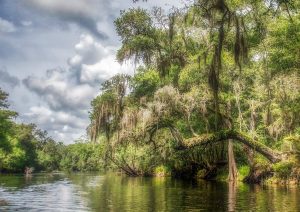
Trees: There is a wide variety of hardwood trees along The Santa Fe – Bald Cypress -Taxodium distichum, Live Oak – Quercus virginiana, Tupelo – Nyssa sylvatica, Cabbage Palm – Sabal Palmetto, Loblolly Bay – Gordonia lasianthus, Dahoon Holly – Ilex cassine, American Sweetgum – Liquidambar styraciflua, Red Maple – Acer rubrum, Carolina Ash – Fraxinus caroliniana, Swamp Dogwood – Cornus racemosa, Virginia Willow – Itea virginica
and others.
Shrubs, Grasses, Aquatic and Flowering Plants: The under growth was rich with Bartram’s Airplant – Tillandsia bartramii , Pickerelweed – Pontedaria cordata , Elliott’s Aster – Symphyotrichum elliottii, Blue Flag Iris– Iris viginica, Cardinal Flower – Lobelia cardinalis , American Eelgrass – Vallisneria americana, Hydrilla – Hydrilla verticillata, Water Hyacinth – Eichhornia crassipes, Spider Lily – Hymenocallis latifolia, Atamasco Lily – Zephyranthes atamasco, Buttonbush – Cephalanthus occidentalis, Saw Palmetto – Serenoa Repens, Bur Marigold – Bidens aristosa
Santa Fe River Fauna
The Santa Fe River is abundant with wildlife. On a good day you’ll get to see an assortment of river birds to include Herons, Egrets, Limpkins, Ibis, Owls and Ospreys, plenty of turtles, an occasional otter or wild hog and deer. Alligators are few and far between on the Santa Fe, in fact I’ve never seen a gator on the Santa Fe!
Santa Fe River Details
Rum Island to Hwy 47
![]() Location: The Santa Fe River ‘s source is Lake Santa Fe – Little Lake Santa Fe located north of Melrose and East of Waldo in Alachua County. It flows in a westerly direction, meeting the Suwannee River in the northwest corner of Gilchrist county.
Location: The Santa Fe River ‘s source is Lake Santa Fe – Little Lake Santa Fe located north of Melrose and East of Waldo in Alachua County. It flows in a westerly direction, meeting the Suwannee River in the northwest corner of Gilchrist county.
![]() Launch point: The launch point for this paddle is at Rum Island County Park. Take US 27 NW out of High Springs for 3.3 miles from downtown. Turn left on CR 138 and travel 2 miles. Turn left on Rum Island Road and travel 1.5 miles to the park and launch.
Launch point: The launch point for this paddle is at Rum Island County Park. Take US 27 NW out of High Springs for 3.3 miles from downtown. Turn left on CR 138 and travel 2 miles. Turn left on Rum Island Road and travel 1.5 miles to the park and launch.
![]() Paddle Distance: This paddle is 5.2 miles, taking into account some side paddles to Gilchrist Blue and Ginnie Springs.
Paddle Distance: This paddle is 5.2 miles, taking into account some side paddles to Gilchrist Blue and Ginnie Springs.
![]() Difficulty: Easy to moderate. The river is open with a nice easy flow. I say moderate only if water levels are low as there may be shoals and rocks. Today’s paddle was with a swift flow which added some fun corners to go around.
Difficulty: Easy to moderate. The river is open with a nice easy flow. I say moderate only if water levels are low as there may be shoals and rocks. Today’s paddle was with a swift flow which added some fun corners to go around.
 Average Paddle Time: Today’s paddle, which included stops at Gilchrist Blue, side paddles to Naked Spring, Little Devil and Ginnie added some extra time. Out total paddle today took 2 hours 40 minutes.
Average Paddle Time: Today’s paddle, which included stops at Gilchrist Blue, side paddles to Naked Spring, Little Devil and Ginnie added some extra time. Out total paddle today took 2 hours 40 minutes.
![]() Width and Depth: The water level was high and the average width of the navigable river is about 170′ wide.
Width and Depth: The water level was high and the average width of the navigable river is about 170′ wide.
![]() Current – Tidal: The flow was swift due to the amount of rainfall this summer and made for a fun, easy paddle.
Current – Tidal: The flow was swift due to the amount of rainfall this summer and made for a fun, easy paddle.
![]() Side Paddles: There are numerous side paddles on this section of the river. The side paddles are short as they lead to the many springs along the route. Neither of the side paddles are of any great distance. These include Gilchrist Blue run, Naked Spring, Little Devil Spring and Ginnie Spring. Due to the high water levels, several of the spring runs were completely covered.
Side Paddles: There are numerous side paddles on this section of the river. The side paddles are short as they lead to the many springs along the route. Neither of the side paddles are of any great distance. These include Gilchrist Blue run, Naked Spring, Little Devil Spring and Ginnie Spring. Due to the high water levels, several of the spring runs were completely covered.
![]() Rest Areas: There are numerous areas to stop and rest along this section of the river. Many of the larger springs have public restrooms available. Due to high water levels some familiar rest stops were submerged.
Rest Areas: There are numerous areas to stop and rest along this section of the river. Many of the larger springs have public restrooms available. Due to high water levels some familiar rest stops were submerged.
Rum Island to Hwy 47 Paddle Map
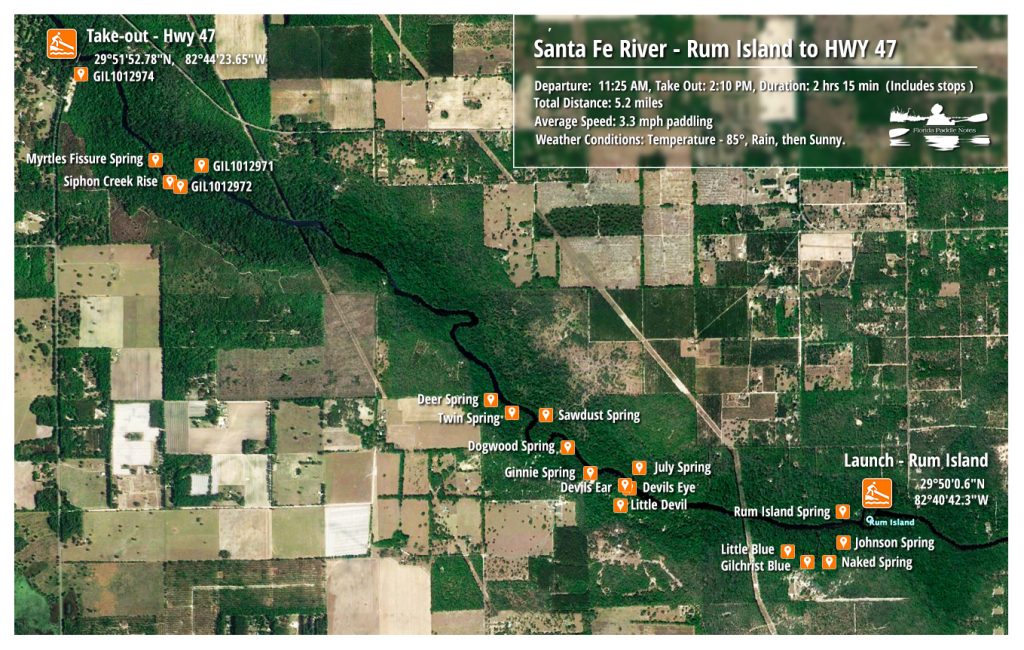
The Sky is Crying
As I mentioned in my initial post on the Santa Fe River, this river has always been special to me. Having lived on 5 acres, walking distance up the then dirt road from the river, I spent many days exploring the springs and boating the river. Each time I return I recall fond memories, and though it’s been over 45 years ago that I first moved here from Miami, it’s almost like coming home!
Today’s paddle with the Boll Green Aquaholics was one not to be missed! I’ve done several previous paddles covering sections from HWY 27 bridge outside of High Springs, to Sawdust Springs and today we’re going up further to the take-out on Hwy 47. It has been so long since I’ve been on the section covering Hwy 47 and I was looking forward to visiting Siphon Creek and Myrtle’s Fissure! Despite a sketchy weather report, we met at 11:00 am, unloaded our boats and gear and proceeded to set up our shuttle needs, driving some vehicles to the take out on Hwy 47. By 11:30 we were launching under a brief drizzle but nothing too bad, although the sky was threatening more!
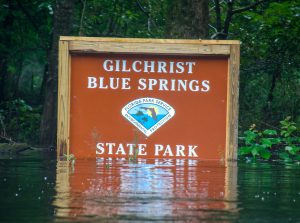
It was obvious when we arrived that the water level was high and the current was swift. Having had an abundance of rain over the Spring and Summer, most of the rivers of recent paddles have also been high and fast. We launched and proceeded about a tenth of a mile down river to the Gilchrist Blue Springs run. The state park sign was a definite indicator on the water level height.
This run, which as about 1200′ long, leads into Gilchrist Blue Springs State Park. When the water levels are lower this particular run is quite swift as it flows into the Santa Fe River. Today with the higher water level, it was quite manageable. Upon entering the run we paddled ‘Into the Mystic’. As a result of the brief rain, the water temperature and the air temperature, there was a mist covering the surface. It was very cool!
When it rains it pours
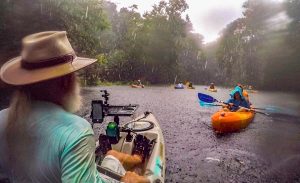
As we exited Blue Springs run, the sky opened up, the wind blew and we were paddling in a good old Florida Palmetto Pounder. It was raining so hard in fact that we decided to take refuge under the dense canopy of Bald Cypress, Carolina Ash and Black Gum. It was amazing how this dense canopy provided such good relief from the rain. With the water level high we were able to paddle among many Cypress Knees and secure our boats well.
The rain didn’t last long, perhaps 20 minutes thereabouts and we proceeded to venture out from our hidden sanctuary along the riverside. I didn’t say shoreline because there was no visible shoreline at this point due to the high water. We still had several other springs to visit and thus continued on our journey with clear blue skies ahead of us and threatening skies and thunder slowly following us.
The Springs
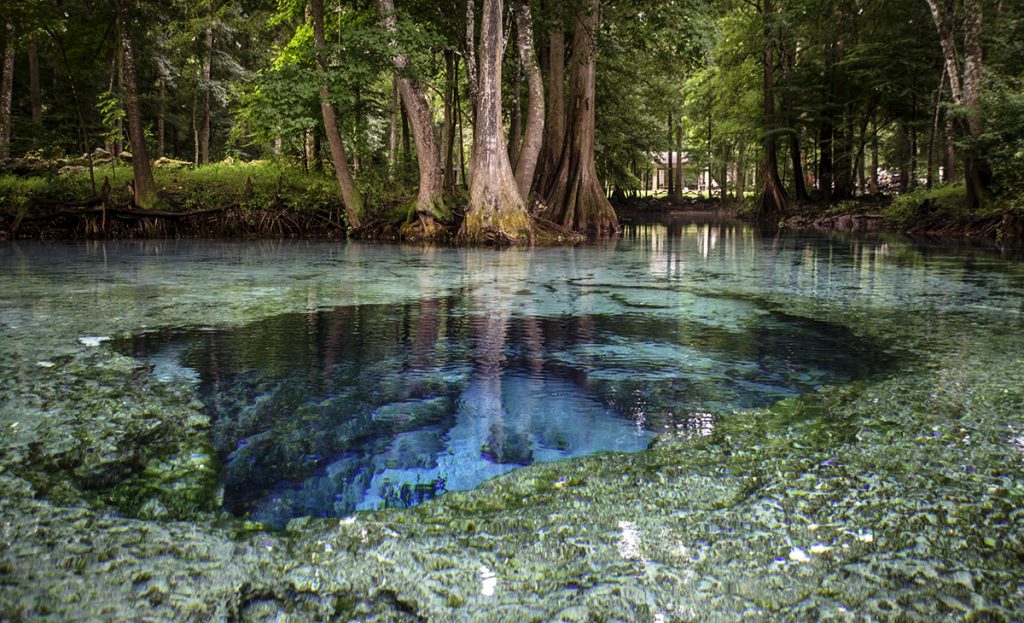
The next group of springs were to be the last we saw. Due to the high water levels, the springs and fissure I was hoping to see further down the line were covered and unnoticeable. Even the few on our next part, listed below, were visible but the water was very clouded from the limestone run-off from all the rain. July spring seemed to catch all the plant debris floating down river and was not visible. Sawdust spring as well, browned out. For a more in depth look at location and descriptions, open the interactive springs map or look over several of the Maps and Guides listed above…
- Devils Eye, Devils Ear and Little Devil are just under a mile downstream from Gilchrist Blue ( 5 mi from launch ). These are popular diving springs and they are so awesome! If you are short on time do not miss these springs. See photos below…
- July Spring is a nice spring right across the river from the Devil system. It is surrounded by private property so enjoy the water but keep off the land.
- Ginnie Spring is up next very quickly on the left. A large gorgeous spring to explore with plenty of lime rock support to stand on and observe.
- Sawdust Spring is the final spring on this paddle at 5.7 miles from launch. Another spring on private property but the underwater scenes here are beautiful!
Santa Fe River Springs Photo Gallery
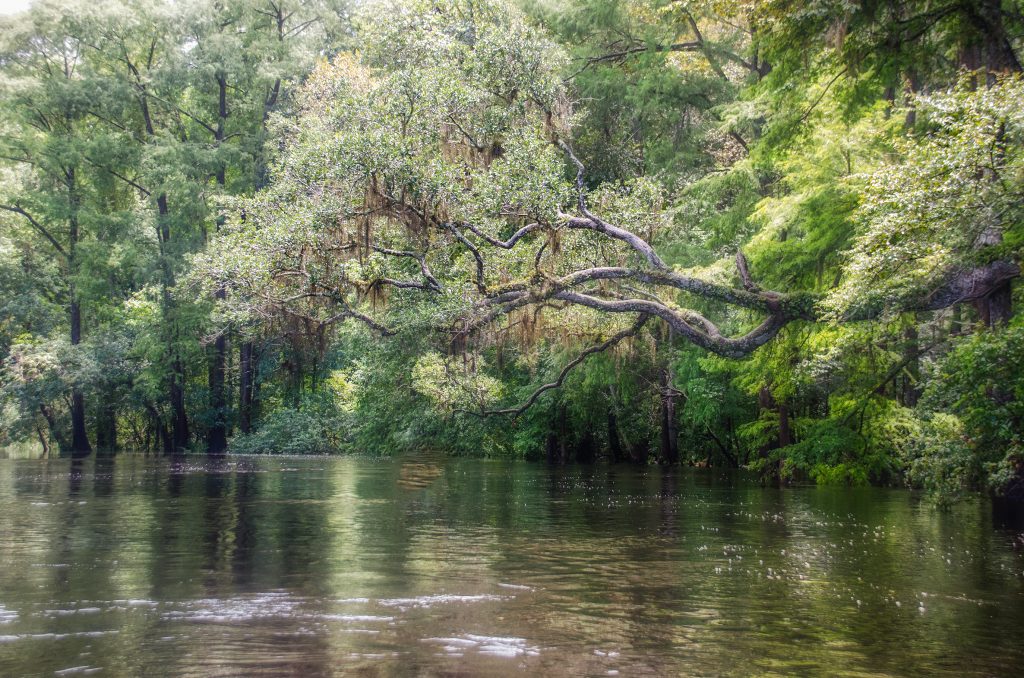
Let the Sunshine
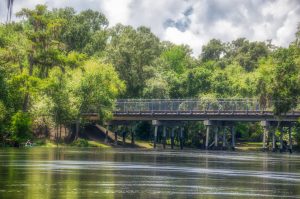
As we proceeded down river we paddled over several eddys, that, along with the swift current, provided short thrills. By this time the sun was out, the sky was blue, though it was still cloudy and thundering behind us. The beauty of the river was really exposed as the sun created contrast on the different species of trees. The current made this paddle so relaxing as well as quick. Before we knew it, our destination was ahead and so ended another great day of paddling Florida waterways and another chapter in Florida Paddle Notes.
Santa Fe River Flora

Trees: There is a wide variety of hardwood trees along The Santa Fe – Bald Cypress -Taxodium distichum, Live Oak – Quercus virginiana, Tupelo – Nyssa sylvatica, Cabbage Palm – Sabal Palmetto, Loblolly Bay – Gordonia lasianthus, Dahoon Holly – Ilex cassine, American Sweetgum – Liquidambar styraciflua, Red Maple – Acer rubrum, Carolina Ash – Fraxinus caroliniana, Swamp Dogwood – Cornus racemosa, Virginia Willow – Itea virginica
and others.
Shrubs, Grasses, Aquatic and Flowering Plants: The under growth was rich with Bartram’s Airplant – Tillandsia bartramii , Pickerelweed – Pontedaria cordata , Elliott’s Aster – Symphyotrichum elliottii, Blue Flag Iris– Iris viginica, Cardinal Flower – Lobelia cardinalis , American Eelgrass – Vallisneria americana, Hydrilla – Hydrilla verticillata, Water Hyacinth – Eichhornia crassipes, Spider Lily – Hymenocallis latifolia, Atamasco Lily – Zephyranthes atamasco, Buttonbush – Cephalanthus occidentalis, Saw Palmetto – Serenoa Repens, Bur Marigold – Bidens aristosa
Santa Fe River Fauna
The Santa Fe River is abundant with wildlife. On a good day you’ll get to see an assortment of river birds to include Herons, Egrets, Limpkins, Ibis, Owls and Ospreys, plenty of turtles, an occasional otter or wild hog and deer. Alligators are few and far between on the Santa Fe, in fact I’ve never seen a gator on the Santa Fe!
Wildlife Gallery:
Santa Fe River at the Ichetucknee River
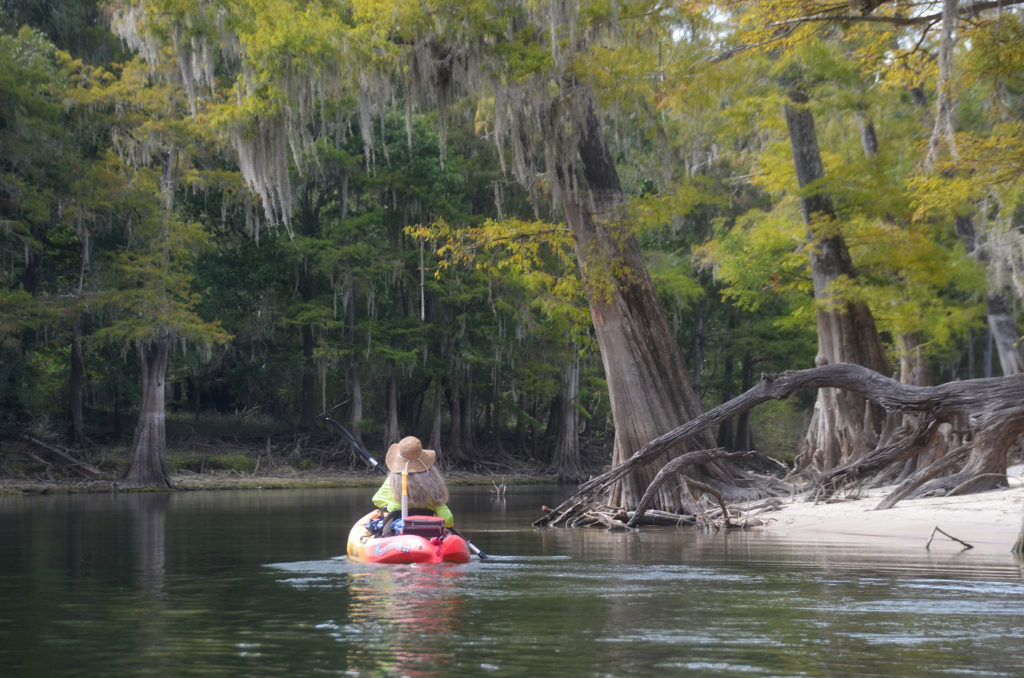
With temperatures finally on the cool side, we headed back to an old favorite, the Ichetucknee River and a portion of the Santa Fe River. This is a 10 mile paddle, launching in Ichetucknee Spring State Park, paddling down 6 miles to the Santa Fe River and four more miles to our take out at at Guy Lemmons Memorial Park, Hwy 129.
The water was just under 2 feet lower than our paddle in April of this year, exposing the numerous and intriguing network of interlaced tree roots and Cypress Knees. We were also fortunate to have almost no boat traffic at all. A few paddlers launched ahead of us at the head spring, were only seen a couple of times and except for a couple of boats where the Ichetucknee River meets the Santa Fe River, we encountered only one other boat for our final 4 miles!
It was a very relaxing paddle with a hint of Fall in the air. The water was clean on both rivers and the lack of Tannin in the Santa Fe River was quite noticeable. Herons, Egrets, several species of Limpkins, an Eagle and plenty of Turtles, were viewed, especially on the Ichetucknee. The fact that it is Fall, the tubing season being over and it being a weekday made for the peaceful solitude we were able to enjoy!…James
![]()
The Ichetucknee – Santa Fe River Paddle Map
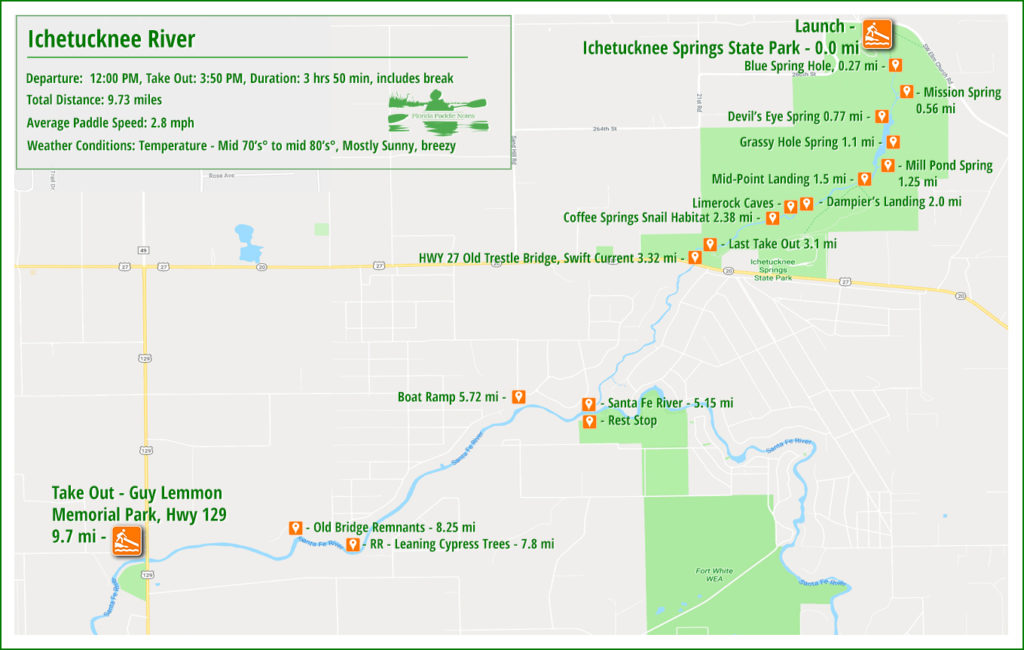
Ichetucknee/Santa Fe River Gallery
Guides, Maps & Info
- River Rise Topo Map…
- River Rise Preserve State Park…
- O’Leno St. Park…
- The Geology of River Rise and Santa Fe Sink…
- Karst Hydrogeology of The Santa Fe River Basin – PDF…
- Water Level at River Rise…
- Santa Fe Canoe Outpost…
- oursantaferiver.org has a few nice maps and guides for this river…
- Florida Springs Database by Greg Johnson…
- A great interactive map for Florida Springs. This opens in Google Earth for me…
- floridaspringlife.com has a good interactive map of Santa Fe River Springs…
- Florida Designated Paddling Trails – Santa Fe River Guide (pdf)…
- 5-Star Yak Pak.org has a great detailed Santa Fe Fact Sheet Mileage Chart…
- Suwannee River Water Management District has an excellent (pdf ) covering Springs on the Santa Fe River…
- Springs Fever also has excellent information on the Santa Fe River and each spring (pdf )…
- Ichetucknee Topo Map…
- Ichetucknee Springs State Park…
- Florida Springs – Ichetucknee Springs…
- Ichetucknee Springs Information…
- Ichetucknee River Paddling Guide…
![]()

